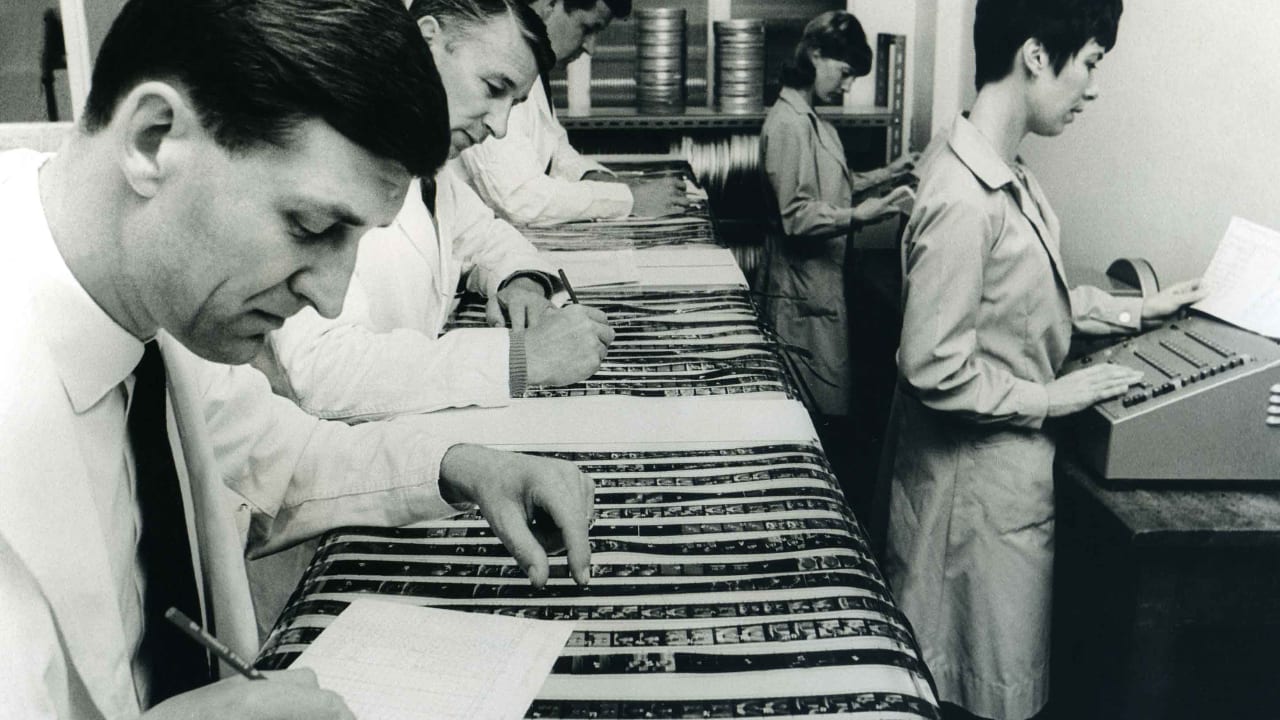
Roland Denning on the lost world of the film laboratories, a glimpse into a technology, and even a society, that is fading fast in memory.
I remember visiting the last film laboratory in London’s Soho – it felt I was at a turning point in history. Upstairs were the video suites, all leather sofas and bowls of fruit and in the basement was the film lab: men in white coats, pipes running under gratings and tanks of toxic chemicals - two very different worlds. Filmmaking was very much an industrial process, and film editing rooms were workshops, more cobblers’ back rooms than design studios. Thousands of people were employed in the labs and it was a way into the industry for many. A recent documentary titled The Golden Age Of Film Laboratories shines a light on these forgotten people.
The premiere screening was held, appropriately, at the splendid The Cinema Museum in Lambeth, London. The museum, housed in a Victorian workhouse which Charlie Chaplin once inhabited, is an essential destination for anyone interested in the past technology and paraphernalia of cinema.
Old school workflow
Many today will not be familiar of the chain of services that labs provided. Film negative from the camera would be sent to the labs to be developed overnight (anti-social hours were all part of the job). A one-light (ungraded) rush print (dailies to Americans) would be struck from the negative and delivered the next morning to the filmmakers. The rush print would be synced to the audio tracks on 16 or 35mm magnetic film to become the cutting copy for editing. After editing, the negative would be conformed to match the cutting copy by using the edge numbers from the negative (neg cutting – another labour intensive, arduous, forgotten role often assigned to women). The negative would then be graded using a colour analyser that would control the three primary colours in the printer (yes, just the three primaries - incredibly primitive compared to what digital grading can offer today).
Developing the negative itself was a standard and rigorously controlled process (constant temperature and cleanliness of the developing tanks were essential). DoPs who wanted special processes, like forced development (increasing the effective film speed), flashing (to reduce contrast) or bleach bypass (to increase contrast and reduce saturation) knew they were taking huge risks as these processes were irreversible.
Labs were also responsible for fades and dissolves, usually cued in the printer via notches on the edge of the negative, and only available in certain standard lengths (anything more sophisticated need the use of an optical printer, another department in the labs). An ‘answer print’ would be struck from the cut negative and further grading adjustments made on subsequent prints until the producers and director were happy. Finally, an internegative would be made from the negative from which release prints would be produced. The audio would be mixed in a dubbing studio to produce an optical track on the release prints (within television, the audio would remain on a separate magnetic track).
In addition to the big film labs, TV companies had their own labs to develop 16mm reversal onsite – a faster and simpler process which could take place in a couple of hours. Reversal was used not only for news but for documentaries up into the 1980s. Reversal had a latitude of about half a stop, and generally it was the camera original film that was cut – and cuts once made, could not be undone. A very unforgiving process. While 16mm negative carried on being used in the UK well into this century (35mm continued in the USA), increasingly the negative was telecined straight to video and, later, to digital.
With great power…
The labs had considerable power and responsibility. The power came with the ability to blacklist a film if it contravened union rules in some way. The responsibility from the fact the delicate, unique negative was worth thousands of pounds - unlike today, there was no way of backing up undeveloped rushes. Labs could be blamed for sub-standard results even if the error originated in the camera department.
Today, film labs are few and far between. Those that exist do so largely to develop negative that is immediately scanned to digital. Since almost all exhibition and post production is now digital, 35mm film prints are now a process limited to a few specialist labs, and 16mm print services have become almost non-existent.
In the UK, up until the reign of Margaret Thatcher, the film union (ACTT in those days) was a closed shop – you couldn’t get a job without a union ticket, you couldn’t get a union ticket without a job. One way in was via the labs where you would get a low grade job and a union ticket with a ‘9C restriction’ – which meant for two years you had to stay at the same grade and in the same class of work before you could move on.
The labs were a way that working-class men and women could gain an apprenticeship and work their way up; few had university qualifications. Today, the nearest equivalent to working in a lab is becoming a runner for a post-production company, but runners are more like interns, and they tend to be those from more affluent families who can afford to work for next to nothing. You could say the film and TV world today is much more middle class as a result.
The Golden Age Of Film Laboratories, directed by Andrew Dawson & Sean P Holmes, can be viewed here. The filmmakers also produced an earlier film, Women in West London Film Laboratories.
Tags: Production


Comments